Our 2021 Toyota Sienna Departs on a High Note
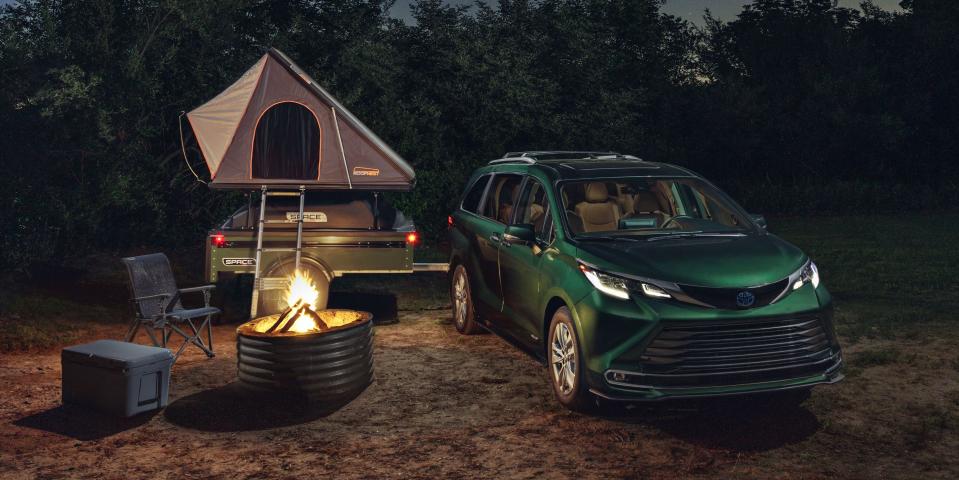
From the July/August 2022 issue of Car and Driver.
40,000-Mile Wrap-Up
Would you ever believe that this green—literally, not figuratively—hybrid was the most popular car in our long-term fleet during its 12-month tenure? "No way," you say. Well, despite that we have a parking lot filled with the likes of a BMW M3, a Porsche 718 Cayman GTS 4.0, a Chevrolet Corvette, and a Ram 1500 TRX, a minivan—the terminally underappreciated automotive breed that new dads fear and cool moms look down on—was in fact the most popular. Our 40,000-mile test took 350 days. Why was that? Simple: This is one highly evolved minivan.
This all-wheel-drive Sienna Limited arrived back in May 2021, and it stickered for $51,885. We might have gone for a lesser trim, but when we saw Cypress green on the options sheet, we knew that was the van for us. Limited is the lowest trim in which the color was available, and while it's $1960 less than the Platinum, we felt that the Limited had everything we wanted: leather seats, sliding second-row captain's chairs that shuffle rearward far enough to make Yao Ming smile, more USB outlets than a Delta Sky Club lounge, and a 245-hp hybrid powertrain consisting of a 2.5-liter inline-four, three electric motors, and a small traction battery.
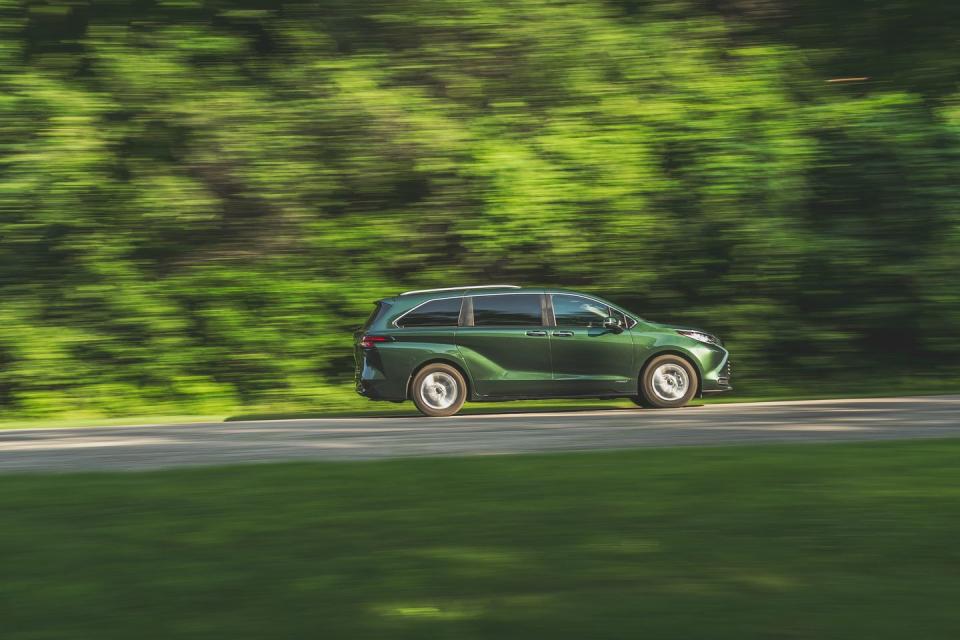
When new, the Sienna hit 60 mph in 7.6 seconds and slinked through a quarter-mile in 15.7 seconds at 89 mph. These aren't numbers that stir one's loins, but that is just as quick as a previous-generation 2015 Honda Odyssey, so if you're so evolved that you go from van to van, with or without the need to chauffeur dependents, it'll feel normal. Also unremarkable are 0.77 g on the skidpad and 194 feet to stop from 70 mph.
Instead, this minivan was at the top of everyone's list because of sexy attributes like ease of ingress, the ability to carry seven people and nine suitcases at the same time, unencumbered visibility, and more storage cubbies than an IKEA display. We'll pause while you catch your breath and call your local Toyota dealer.
The biggest complaint was powertrain noise. Don't be misled by the 67-decibel cabin din at 70 mph—on paper that's quite comfortable and below "average office noise," according to the Hearing Health Foundation. But that was recorded at a steady 70 mph. Frequent acceleration can be soul-crushing. For example, say you're cruising at 75 mph (where the Sienna sips fuel at 33 mpg), and there's an 18-wheeler doing 74 in front of you. Put the accelerator to the floorboard, and the drone that accompanies moderate acceleration could force a Gitmo detainee to break a silence. But keep an active watch on traffic with the cruise control on, and there's no torture.
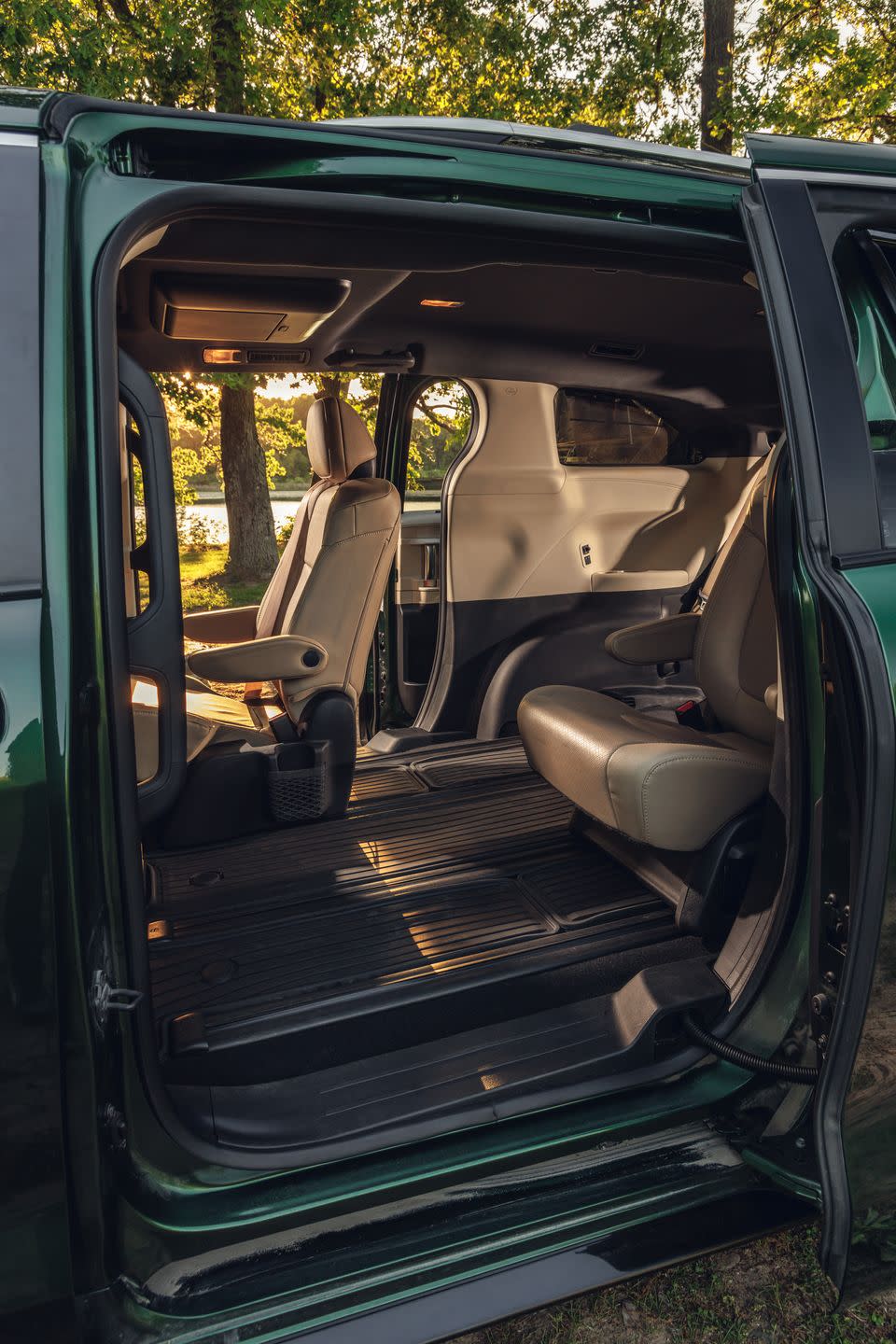
After 40,000 miles, the Sienna lost a bit of the pep in its step, posting a 7.7-second 60-mph time, but that's still quicker than minivans were 15 years ago. And no van from then could average 29 mpg over 40,000 miles. Our long-term 2018 Honda Odyssey returned 23 mpg. The Sienna betters that by 25 percent. That fuel economy is incredible considering many of us drive as if Ann Arbor hosts daily sprint races.
If we factor out all the miles we accumulated on our "winter" tires, we probably would have averaged 32 mpg. But such is the life of a C/D long-term car. We put winter in quotes above because instead of ordering Blizzaks or Hakkapeliittas, we tried a set of Michelin CrossClimate 2s. This isn't your typical winter tire in that it's designed to be used year-round, but it still meets the traction requirements for a Three-Peak Mountain Snowflake designation. We had them on for about 15,000 miles, keeping them well into spring. We estimate they will last 70,000 miles. We didn't test the car on them in dry conditions, but drivers commented on how well the Sienna behaved on them. The typical winter tire has lots of squirm that a sensitive driver can detect, but not these. If that's enough for you to eliminate the biannual chore of swapping tires, these tires are a strong option.
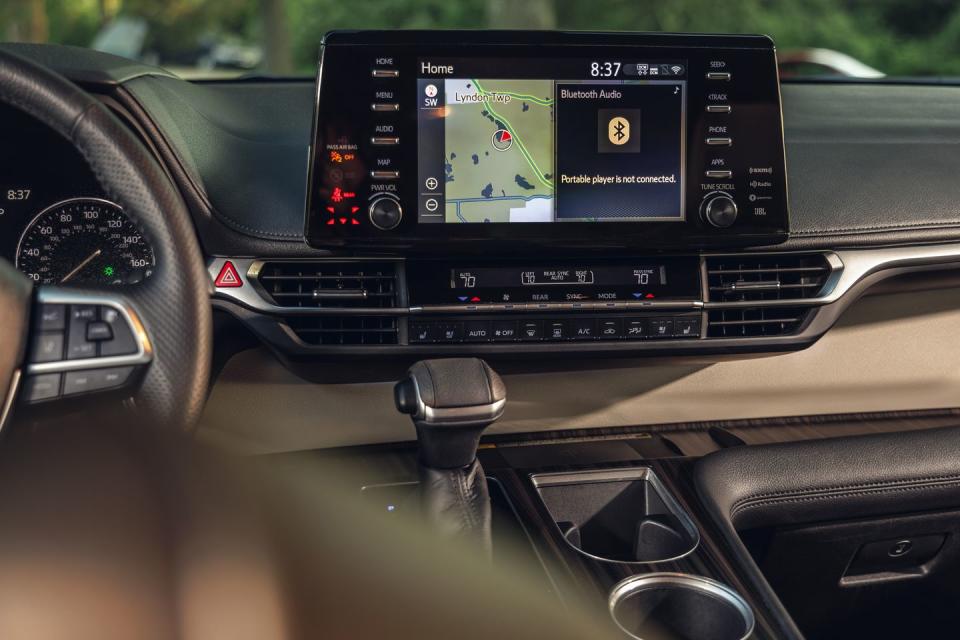
The Sienna traveled as far west as Washington State, as far south as Georgia, and as far east as Cape Cod and Maine. Staff editor Austin Irwin put a roof-top tent on it and used it as his mobile honeymoon suite. It also moved new (re-)hire Greg Fink from Chicago to Ann Arbor on multiple trips. Through all of those miles, there were the typical hybrid quibbles from an atypical hybrid bunch. But everyone agreed that the Sienna was great at moving people and things alike. Big gusts move the sail-sided Sienna on the highway, but what minivan wouldn't be affected similarly?
Our ownership experience is the kind every automaker hopes for when loaning us a long-termer. There were eight trips to the dealer for routine maintenance at 5000-mile intervals. The first five were covered under ToyotaCare's umbrella of no-added-cost service, and the remaining three totaled just $500. The one unscheduled stop turned out to be an issue we could have easily fixed had we noticed it: The seal on the driver's-side sliding door—which, by the way, opens with a kick of the foot under the rocker panel—wasn't seated properly and would interfere with the power-close function. Combined with the low fuel cost, this Sienna earned about as close to a perfect score as possible.
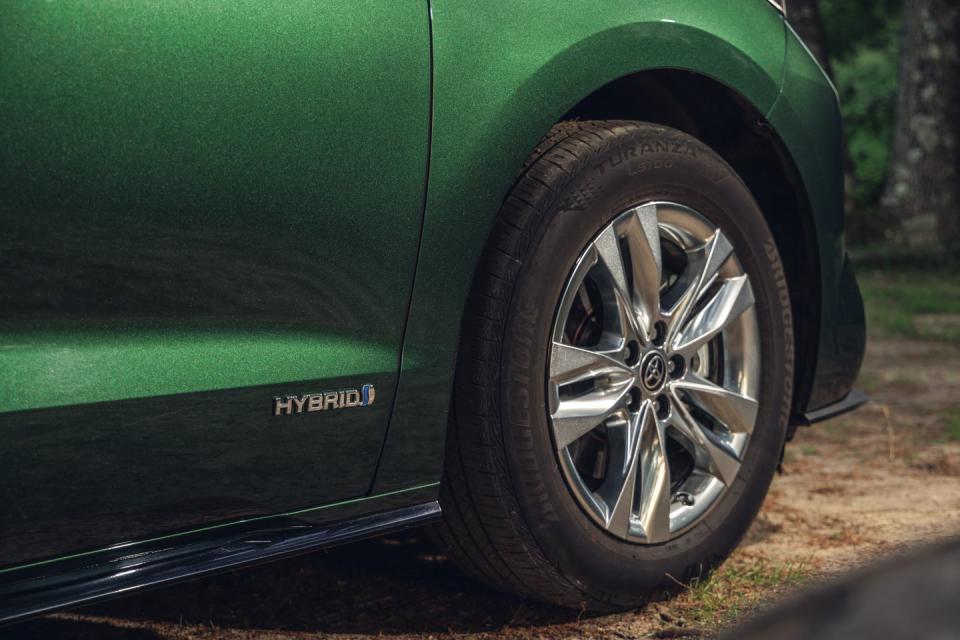
But despite all of this goodness, we did have some legitimate complaints. Parents were frustrated by the rear-seat entertainment screen's lack of iPhone compatibility. We'd probably forgo spending $1415 on the system and just get a tablet to hang on the seatback. When you spec the second-row screen, Toyota also forces the purchase of an AC inverter ($300) and a rear camera mirror ($200), a necessity because the deployed screen completely obscures rear visibility.
Everyone loved the balance of frugality and practicality that the Sienna offers. Bottom line: The good greatly outweighs the bad. This is one fantastic van, and it turns out the rest of the car-buying public agrees, because during 2021 the Sienna became the bestselling minivan on the market. Also in 2021, more buyers flocked to minivans, which saw their market share increase to 5 percent from 4 percent in 2020 (not that 2020 is a benchmark for anything). That may seem like peanuts, but maybe society is evolving too. Soon we will no longer think of the minivan as a penalty box, especially minivans that can save considerable money at the pump over other seven-seaters, the way our Sienna did.
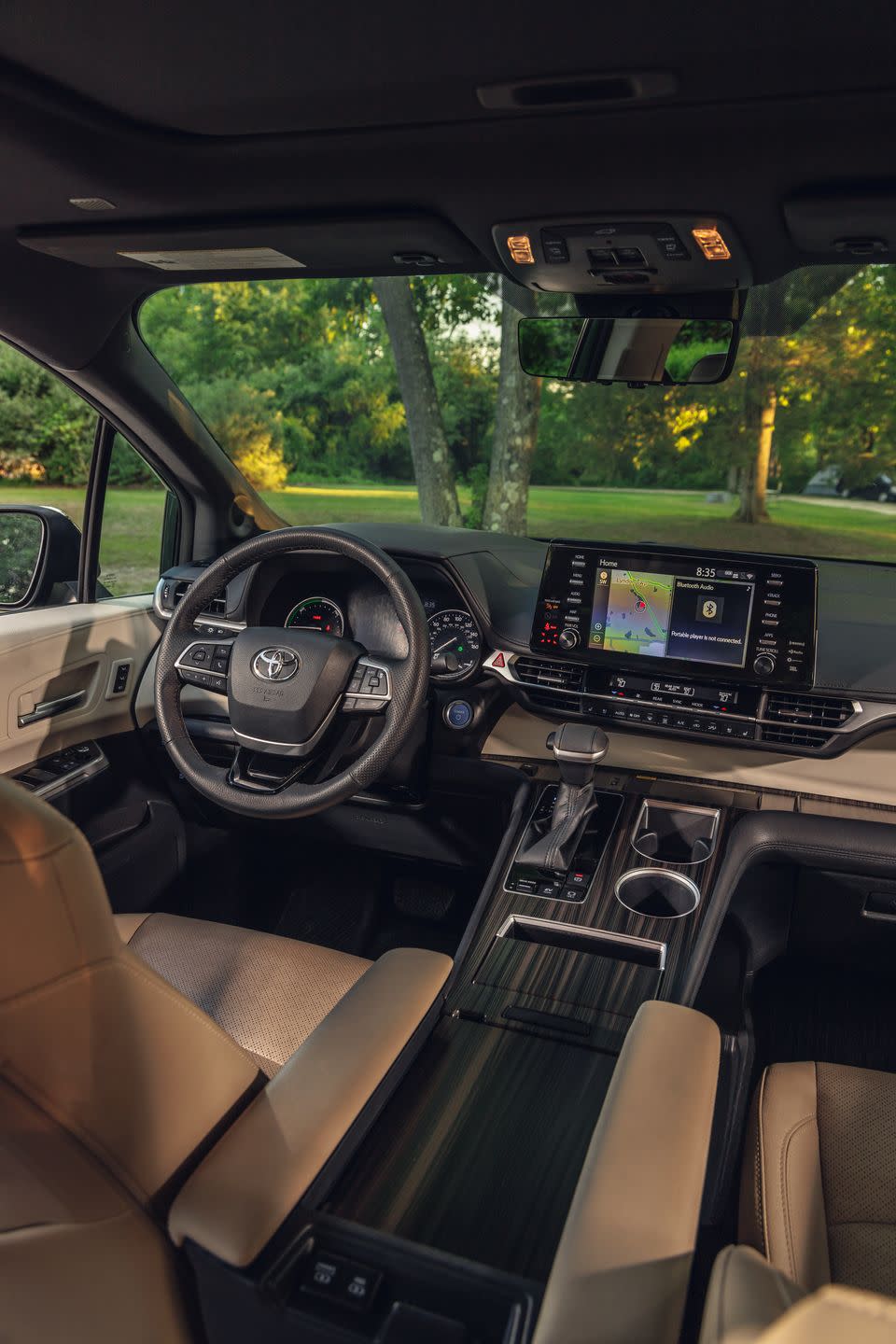
Rants and Raves
Vans get no love, which is sad because they're so useful. The Sienna is so good: a silent, supple, no-BS van with 30-plus-mpg fuel economy and a great interior. —Tony Quiroga
The powertrain isn't bothersome when you're driving gently on flat Michigan roads. But once you get into the hills of Pennsylvania, the engine groans more than my preteen when asked to do her chores. —Dave VanderWerp
Dropping the rear entertainment screen renders the rearview mirror useless. A digital rearview mirror with a camera feed would be nice. —Eric Stafford
It has one, Stafford. —David Beard
I packed this van to the gills for my final move from Chicago, and the extra mass put some sag in the rear end and made the ride quality a bit rougher. Even so, the hybrid powertrain didn't really seem to struggle with the extra weight. —Greg Fink
I still can't believe how quiet this thing is. Add a head-up display and I'm a buyer. —Tony Quiroga
Should we put Quiroga on the spot and tell him that the Platinum trim comes with a HUD? —K.C. Colwell
30,000-Mile Update
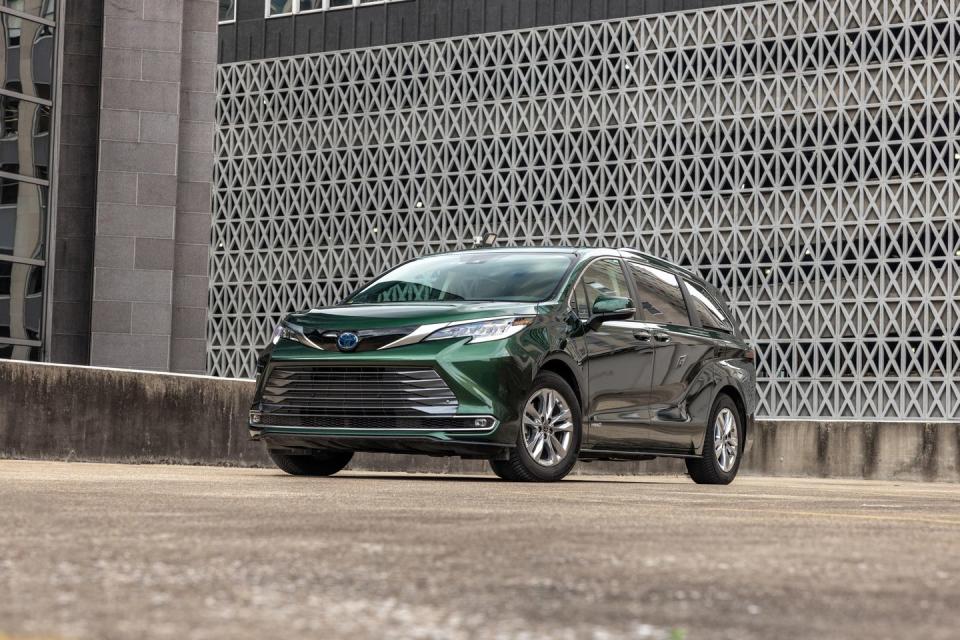
By the 15,000-mile mark, the Toyota Sienna quickly became the top pick among our long-term cars for interstate family adventures thanks to its spacious, practical interior and excellent gas mileage. But as the Sienna approached 30,000 miles, it gained fresh competition for road-trip duty when a 2022 Kia Carnival SX Prestige joined the Car and Driver long-term fleet for its own 40,000-mile stress test. The addition of a second minivan exposed some of the Sienna's flaws, but it also reinforced the Toyota's positive attributes, and the small annoyances weren't enough to outweigh the benefits, with the Sienna remaining a much-wanted vehicle.
Most of the complaints centered around the Sienna's dynamism, or rather its lack thereof. While it would be silly to expect a minivan to slingshot to 60 mph or pull major g-forces when carving a canyon road, the Carnival showed that a minivan can avoid the lethargy that our Sienna at times exhibited. While only three-tenths of a second separate the two minivans in the standard 60-mph acceleration test, our 5-to-60-mph rolling start—which better represents real-world driving—revealed a sizable gap, with the Carnival doing the run in 7.6 seconds, 1.4 seconds quicker than the Sienna. Several drivers complained that flooring the gas pedal in the Sienna produced more engine noise than acceleration, with passing maneuvers on two-lane roads requiring planning and calculation. One editor even pined for "the seriously speedy V-6 in the old Sienna." The Carnival also proved to be a quieter companion, with another commenter complaining that "the Sienna's engine groans more than my almost-teenager when asked to do her chores."
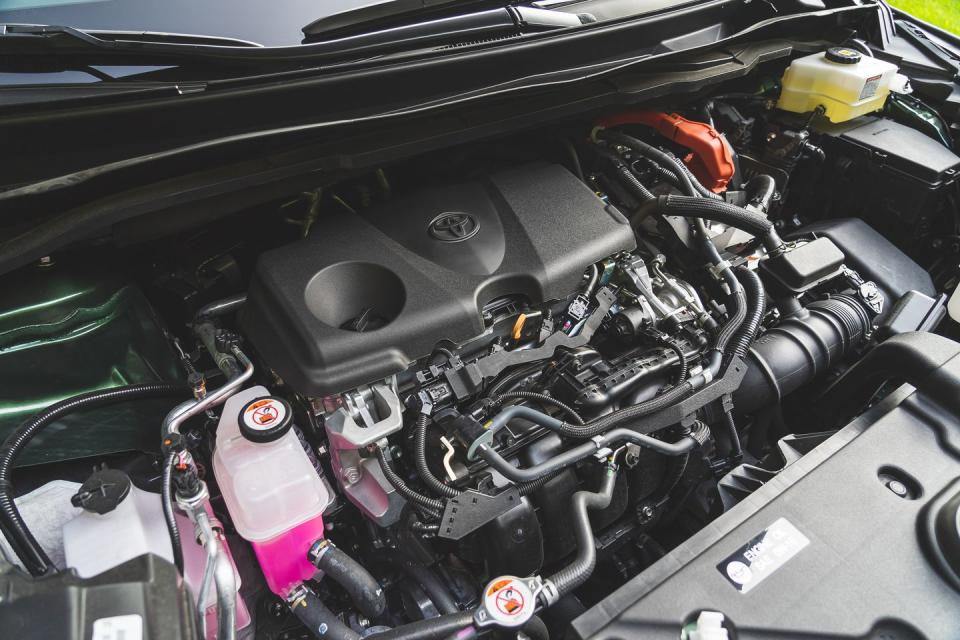
The motor wasn't the only performance trait the Sienna was criticized for. Some staff members took issue with lane wandering on the highway, exacerbated by the ping-ponging of the lane-centering system. And while the Carnival has so far ridden smoothly, the Sienna was also critiqued for its ride, with one editor noting that the van has "more structural shake than even my 80,000-mile Odyssey."
Despite the quibbles with the Sienna's driving characteristics, the Toyota kept impressing on the fuel-economy front—one of the highest priorities for most minivan shoppers. Our best road-trip range so far has been 571 miles, that on a 36.7-mpg run with 2.5 gallons left over. Over all 30,000 miles, the Sienna has averaged a strong 30 mpg. Meanwhile, in its first 10,000 miles, the Carnival returned just 20 mpg from its 3.5-liter V-6. The Toyota's standard hybrid setup really pays off at the gas pump.
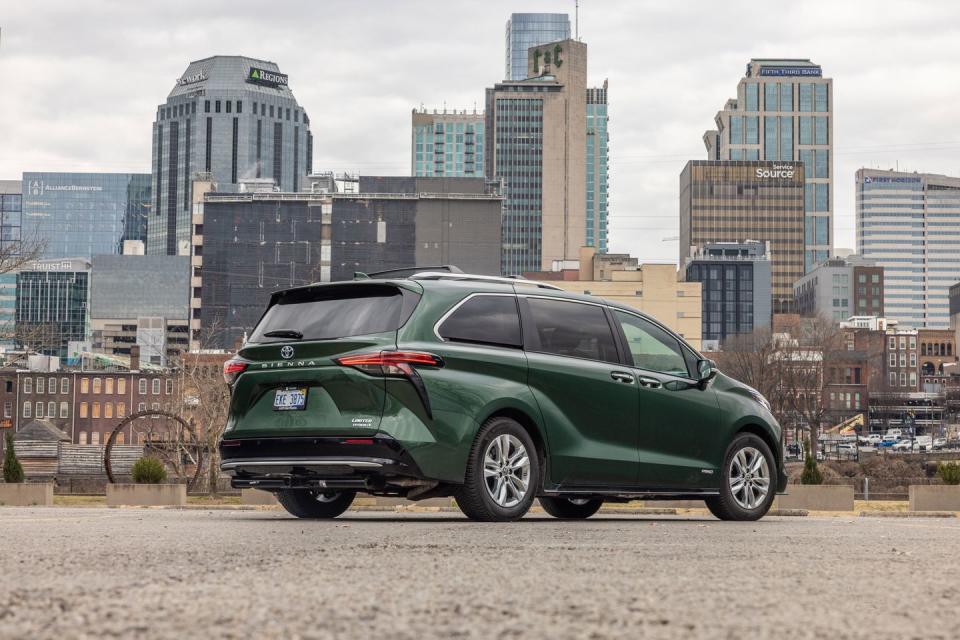
The Sienna's practicality continued to be key to its popularity as a family hauler. The seats were praised for their comfort, and the sliding second-row captain's chairs allowed taller passengers to sprawl out on long drives. The capacious cargo hold swallowed everything we tried to carry. Packing the Sienna to the brim also didn't seem to damper the fuel economy by much—with the Toyota loaded with three adults, a dog, and plenty of luggage, one editor reported still seeing 30 mpg.
The Sienna also continued to uphold Toyota's reputation for reliability. There were scheduled services at 20,000, 25,000, and 30,000 miles, with the first two covered under the ToyotaCare plan—which ends at 25,000 miles. The 30,000-mile visit rang in at $243 and included an oil and filter change, tire rotation, cabin air-filter replacement, and engine air-filter replacement. The rear-entertainment remote control had also started acting up around 20,000 miles and was repaired under warranty with a replacement sensor cover at the 25,000-mile service.
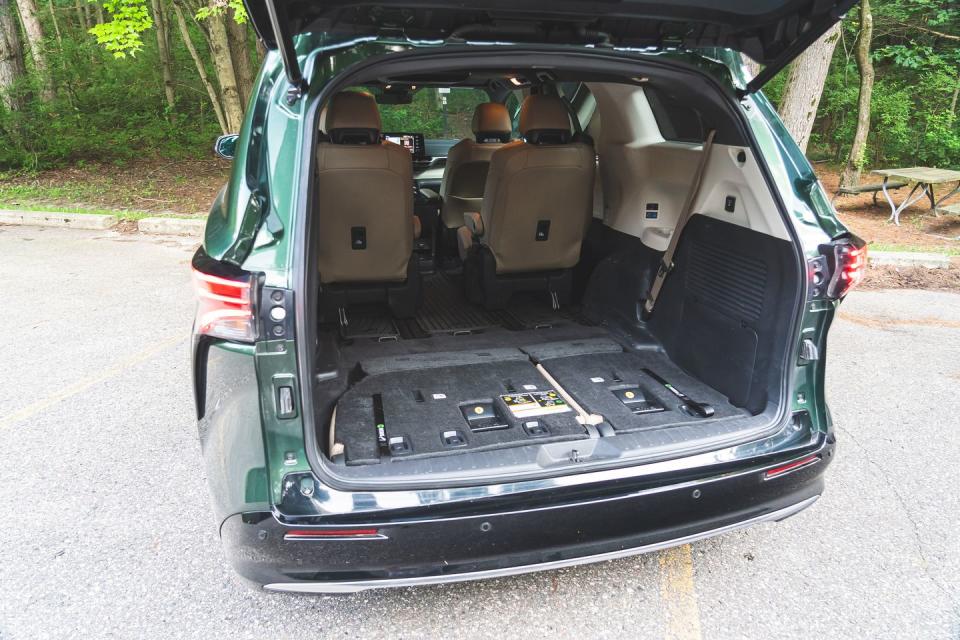
We ran into issues when using a rear-mounted bike rack. With the rack in place, the rear automatic braking got confused, slamming the minivan to a halt every time we tried to reverse. The button to turn off that feature was buried in page two of the driver-assistance menu, and it turned itself back on every time the car was restarted, so driving with the bike rack attached meant an extra step before setting off. But minor problems such as this and the Sienna's lackluster driving characteristics weren't enough to temper the enthusiasm for the Cypress Green family-hauler, and the minivan continued to rapidly approach its 40,000-mile target.
Months in Fleet: 8 months Current Mileage: 30,136 miles
Average Fuel Economy: 30 mpg
Fuel Tank Size: 18.0 gal Observed Fuel Range: 540 miles
Service: $243 Normal Wear: $0 Repair: $0
Damage and Destruction: $0
15,000-Mile Update
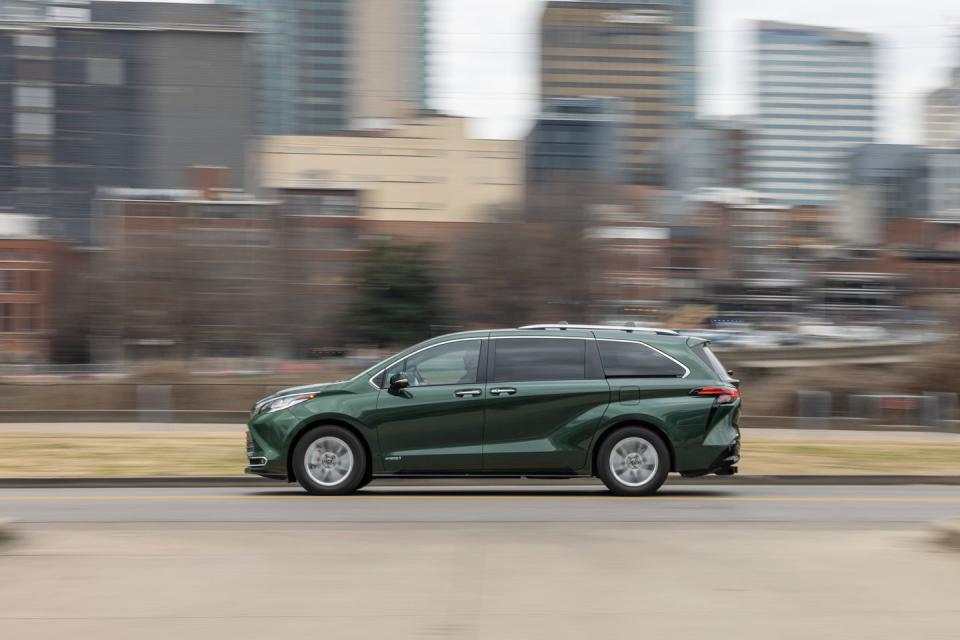
It may be hard to imagine that among a long-term fleet filled with such potent machines as a BMW M3, a Porsche 718 Cayman GTS 4.0, a Chevrolet Corvette, and a Ram TRX, a member of the woefully underappreciated minivan species is one of the most popular. No one on staff ever thinks of the Toyota Sienna when talking shop at the bar, but its popularity and proficiency in moving people and things underscore its versatility as a compelling alternative to an SUV.
Now suspend disbelief for another moment and pretend that this "15,000-mile" update came last summer, when the Sienna's odometer tripped that mark. Between pandemic-related logistic issues, drivers embarking on road trips, and everything else that is daily life, we fell way behind on updating you on life with the Sienna. We'll call this a belated 15,000-mile update with more to come soon.
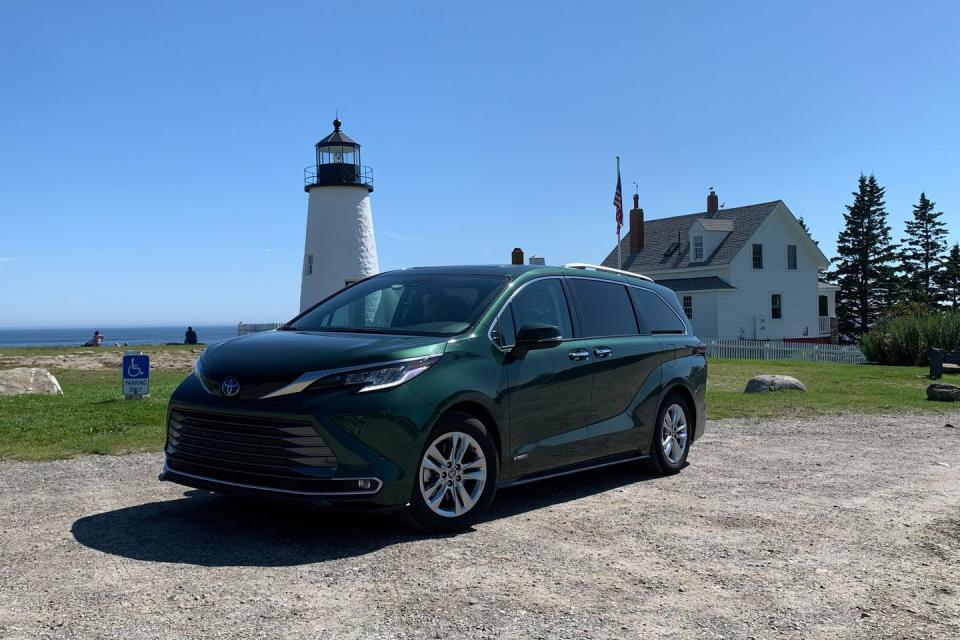
The Sienna's honeymoon phase was rainbows and sunshine. After the very un-Toyota-like unscheduled service stop for what turned out to be a loose bit of weather stripping, the Sienna ran without fault. ToyotaCare covers regularly scheduled maintenance for up to 25,000 miles, and by 15,000, we had taken our green van to the dealer three times at 5000-mile intervals. All service up to this point was relatively basic, consisting of oil changes, inspections, and tire rotations.
As mentioned, the Sienna went to work during the busy summer months. It headed west—very west—to Washington State and south to the Great Smoky Mountains. It also served as the literal honeymoon machine for associate buyer's guide editor Austin Irwin, who installed a Roofnest Falcon rooftop tent for the adventure. This is a clamshell design that goes up and comes down with relative ease—once you muscle it atop the roof. While the Falcon model is no longer available, the Falcon 2 is its direct replacement in Roofnest's line at the same $3595 price as the original. This elevated tent proved to be valuable for Irwin's outing, making for none of the damp mornings that come from ground-based setups as well as preventing his dog from climbing inside and making a mess. The biggest downside to a rooftop tent, he surmised, is that if you want to leave your campsite in your vehicle, you must fold up the tent, which means packing up sleeping bags and anything else you want handy come nightfall.
The Sienna was averaging 32 mpg at this point, and when cruising at 75 mph, it posted an impressive 33 mpg on our highway fuel-economy test. But with the tent folded on the roof, its average fell to the upper 20s (one tank was 25 mpg, another 27). These findings are purely anecdotal, but the fuel-economy hit is worth considering if you're in the market for such a tent. And if you have one, don't leave it on your roof when you're just driving around.
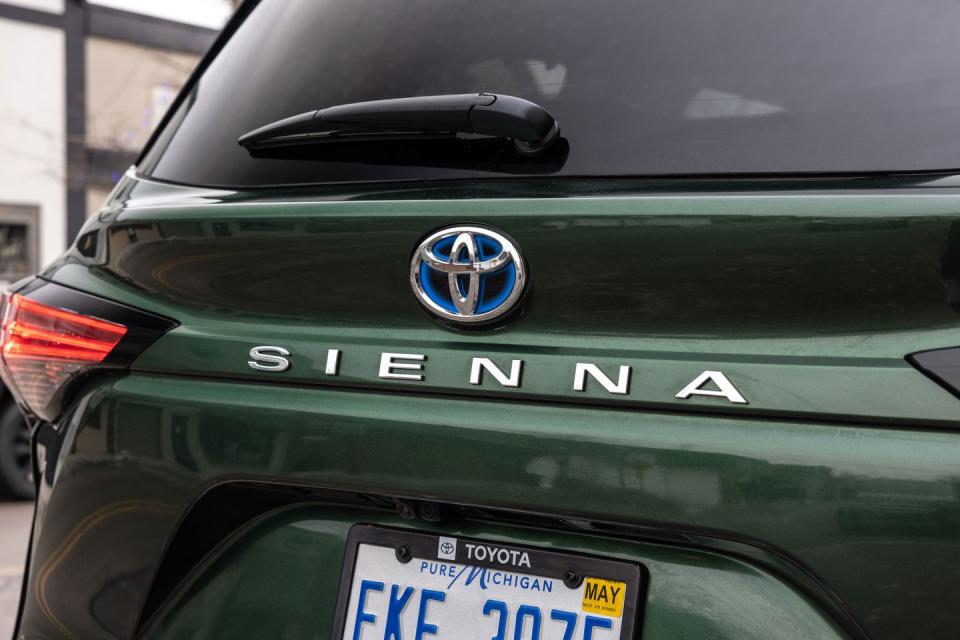
In terms of overall efficiency, the Sienna's is exceptional for a minivan. Our 2018 Honda Odyssey averaged 23 mpg over 40,000 miles, and a 2017 Chrysler Pacifica fared 1 mpg worse than that. The hybrid Sienna's 32-mpg figure is whopping 39 percent better. Of course, you could instead opt for a plug-in-hybrid Chrysler Pacifica, which would return even better mileage if your daily commuting fell within its 33-mile EPA electric range, though we averaged only 29 MPGe with our 2018 example.
For the latest Sienna, everyone seems to love its combination of frugality and practicality, even if most logbook comments mention the hybrid powertrain's penchant for hitting high, whiny notes when you try to pass someone on the highway. Parents also found the rear-seat entertainment system's lack of iPhone compatibility to be frustrating—so much so that we'd probably recommend spending less than the $1415 for the factory system and just buying a tablet or two. When you spec the second-row screen, Toyota also mandates an AC inverter ($300) and a rearview camera system ($200), the latter being necessary because when deployed, the fold-down display completely obscures the rearview mirror's field of view. But the Sienna's virtues wholly outweigh these demerits. Thus far, it has impressively represented its kind.
Months in Fleet: "6" months Current Mileage: "15,000" miles
Average Fuel Economy: 32 mpg
Fuel Tank Size 18.0 gal Observed Fuel Range: 570 miles
Service: $0 Normal Wear: $0 Repair: $0
Damage and Destruction: $0
Introduction
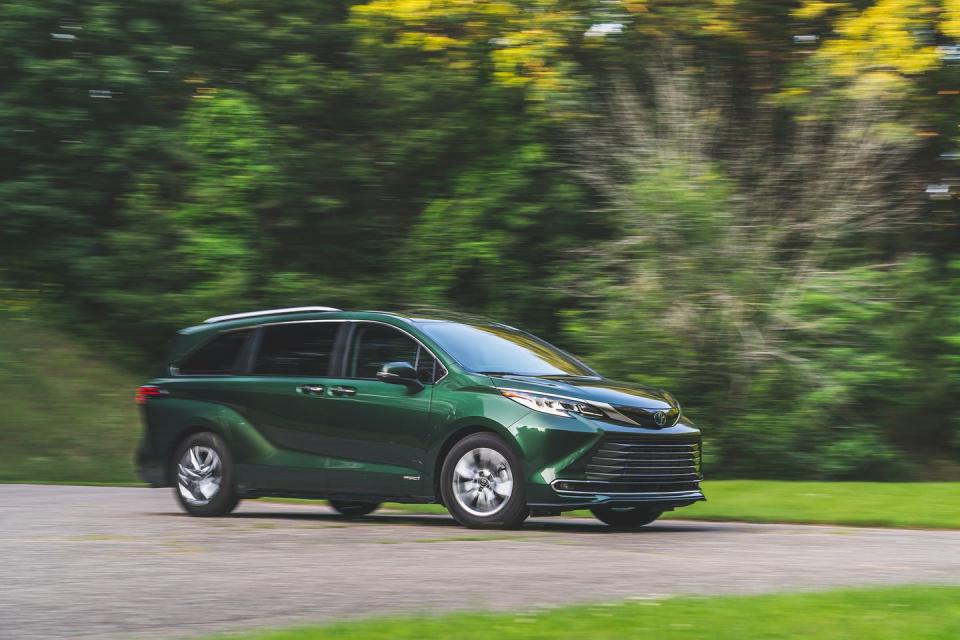
No one ever thinks minivan is the answer when asked: What car is a group of automotive journalists most likely to jockey for? But it is. Give us a minivan and we are instantly reminded of how much we love a practical machine. Our long-term Toyota Sienna did just that. It has been in all but constant motion since it arrived in late May, taking trips as the family schlepper du jour of the C/D long-term fleet.
If you didn't know, the Sienna is new for 2021, and while it doubled down on grille proportions that border on comical, the important news is the powertrain: All Siennas are hybrids. This move netted the people mover a whopping 15-mpg improvement in the EPA combined metric. Front drivers are now 36-mpg machines, and all-wheel-drive Siennas, such as our long-termer, get a big 35 mpg on the Monroney label.
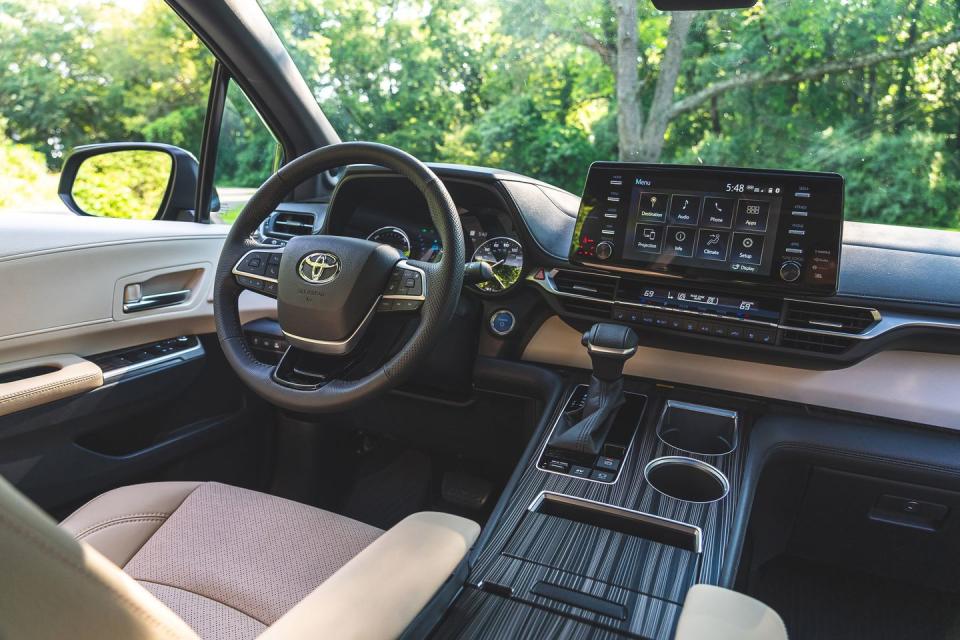
We asked Toyota for a Cypress Green Sienna, a color only available on the top two trim levels. We went with the penultimate Limited. It costs less than $50,000 to start, but once we got the rear-seat entertainment ($1415), an AC power inverter ($300), a rearview mirror that can also display a video feed should your van be loaded to the gunwales ($200), a mini spare tire ($75), and $220 in all-weather floor mats, we ended up with a $51,885 machine. There are eight-passenger versions, but Limiteds have only seven seats, and those second-row captain's chairs are much more comfortable than the Stow 'n Go seats in a Chrysler.
Unlike all-wheel-drive Siennas of yore, the rear axle is directly driven by a motor. There's no driveshaft, just like in other all-wheel-drive Toyota/Lexus hybrids. Both front- and all-wheel-drive models produce the same 245 horsepower because the electric power is limited to what the hybrid battery can produce. Initial testing revealed a 7.6-second 60-mph time and a quarter-mile elapsed time of 15.7 seconds. That's about how it feels. A Honda Odyssey is 1.1 seconds quicker, and the previous V-6-powered Sienna was quicker than the new one as well.
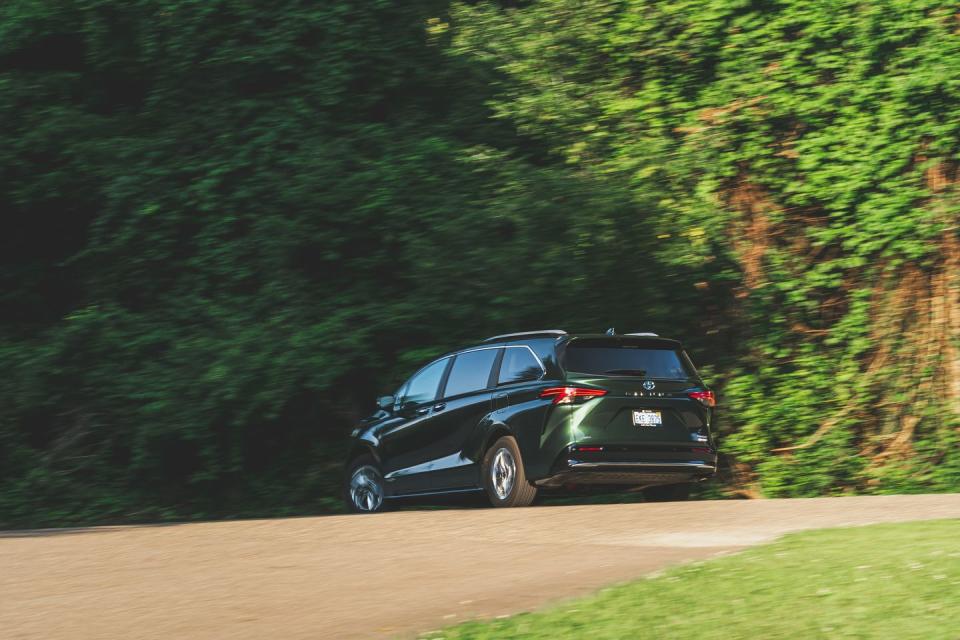
At least that swap to hybrid pays off at the pump as we've averaged 32 mpg so far. That's 39 percent better fuel economy than we saw with our long-term 2018 Odyssey. As with most families making an economic decision, we'd gladly take the savings at the pump at a cost of some droning engine sounds at wide open throttle. Those emanate from the hybrid powertrain's internal-combustion half, an Atkinson-cycle 2.5-liter inline-four. Once moving on the highway and settled into a cruise, the Sienna hums along at a quiet 67 decibels.
Right after the van showed up, the passenger sliding door wouldn't close on its own—a first-world problem, we know—and we took the Sienna to the dealer for a very un-Toyota-like unscheduled service visit to fix it. Turns out we could have easily addressed the problem because the weather stripping had dislodged from its track and was doing a very good impression of a kid's digit. Since then, we've had the Sienna in for two scheduled services. Both were typical—oil, filter, inspections—at 5000-mile intervals.
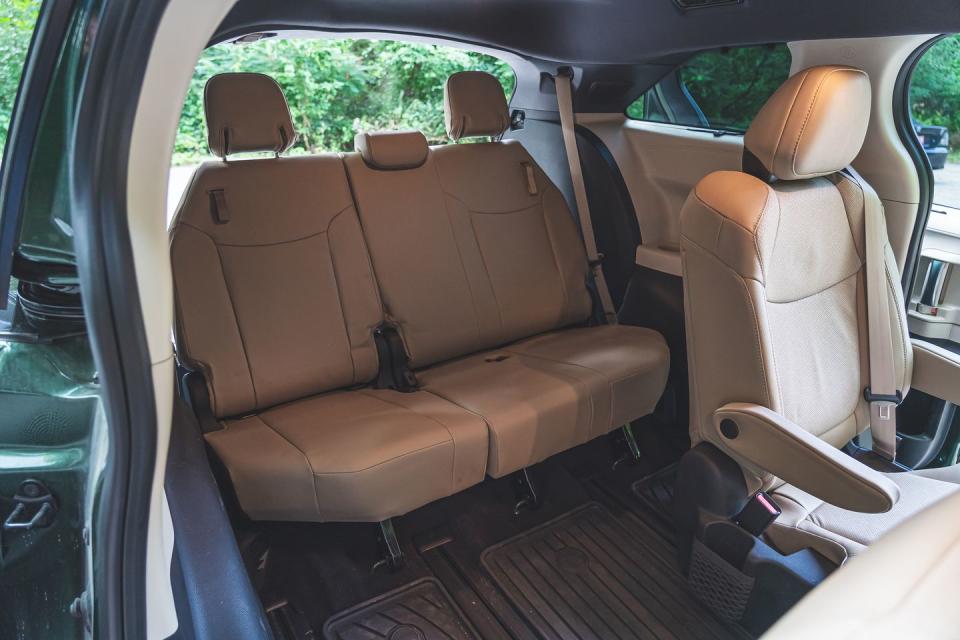
Other than that, the van has been flawless. Some complain about the engine noise while accelerating. The engine droning is very apparent when you get into hilly country. And the van is somewhat lacking in the driver-centric areas such as brake and steering feel. A stiff crosswind does make the Sienna drift, but that's true of most seven-passenger SUVs.
As we mentioned, the Sienna has been in near constant motion since it arrived: Maine, North Carolina, Michigan's Upper Peninsula. Maybe that is due to an uptick in road trips, or because we haven't had a van in a while. Either way it's a staff favorite, and even if it did sit still long enough to gather moss, we'd never know because of its color.
Months in Fleet: 5 months Current Mileage: 10,135 miles
Average Fuel Economy: 32 mpg
Fuel Tank Size 18.0 gal Observed Fuel Range: 570 miles
Service: $0 Normal Wear: $0 Repair: $0
Damage and Destruction: $0

You Might Also Like

 Yahoo Autos
Yahoo Autos 